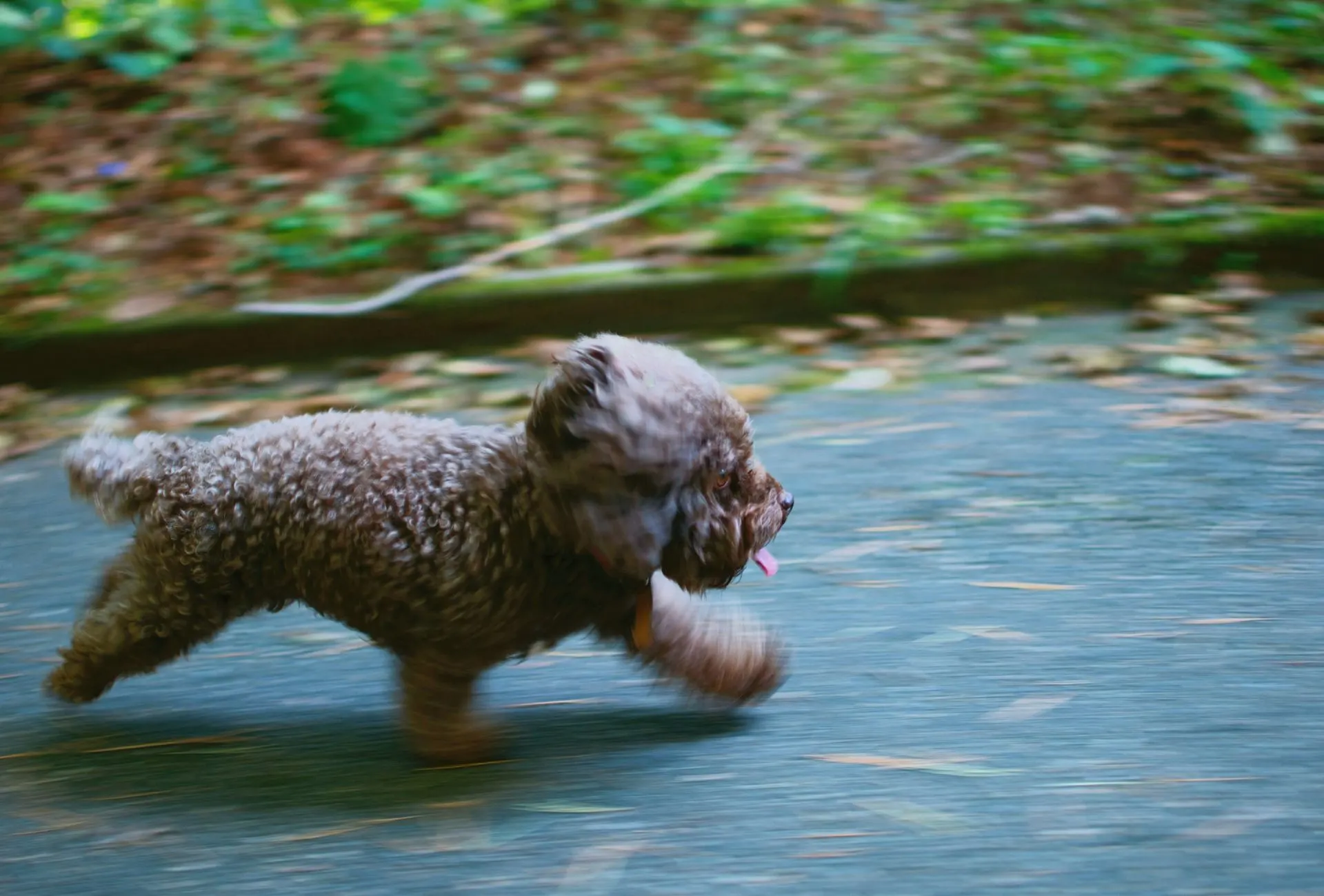Zoomies are incredibly fun to watch and a sign of how excited and happy your dog is at that moment.
But what if your dog displays similar behavior apart from his usual Zoomie triggers?
Changes in our dogs’ behavior are always concerning and can have many underlying reasons.
If your dog runs around erratically he could be suffering from CCD, infections, brain tumors, anxiety, liver disease or pain. However, it can also point to insufficient exercise or that your dog is seeking attention.
Causes for Erratic Running
Before we go into the different reasons for this erratic behavior, we have to clearly draw the line between common zoomies and something more concerning.
Zoomies or FRAP (Frenetic Random Activity Period) are characterized as sudden bursts of energy that last only a short while.
During this, your dog will be running around in circles like crazy to get out all that excess energy.
This usually happens in moments of pure excitement like before going for a walk, after eating, or when meeting another dog.
It can also happen out of pure relief after taking a bath or when pooping.
Your dog will be exactly the same right before and after zoomies and they will mostly occur around the same time/activity.
If this running around doesn’t stop, your dog is acting differently or seems to be uncomfortable during it, then something might be wrong.

1. Insufficient Exercise
The first possible reason for erratic running could be insufficient exercise.
If your dog doesn’t get his required daily amount of exercise, he might try to get rid of excess energy by running around your house.
For some breeds, running circles is actually their preferred type of exercise.
How much exercise your dog needs depends on his breed, age, size, and health.
Also, do not forget to tire your dog out mentally.
Mental stimulation is just as important and can be achieved through training, playing, puzzle toys, nose work, and much more.
2. Canine Cognitive Dysfunction
Erratic behavior can point to neurological issues such as CCD (canine cognitive dysfunction).
This syndrome usually occurs in older dogs and can be compared to dementia or Alzheimer’s in humans.
Dogs with CCD experience behavioral alterations such as disorientation and different interactions with the owner and the environment.
Pacing and other repetitive movements can be a result of disorientation and vision impairment.
Similar to people with Alzheimer’s, dogs can suffer from increased anxiety, phobias, and aggression.
It is usually diagnosed based on clinical signs and a physical exam.
Early intervention is key here and although there is no cure, treatment can increase the quality of life.
Dogs diagnosed with CCD live for around two years on average.
3. Ear Infections
The ears are responsible for hearing and are essential to your dog’s sense of balance.
Ear infections can lead to disorientation and your dog may become off-balance due to the pressure changes in the inner ear.
Compared to humans, dogs are actually far more prone to ear infections due to the shape of their ear canal.
If you suspect that the ears are the cause of your dog’s unusual behavior then make a quick examination.
Do you see any redness, swelling, discharge, or scabs?
Is your dog constantly shaking his head or scratching at the ear?
If so, it’s definitely time for a vet visit who can recommend you a treatment based on your dog’s underlying problem.
4. Brain Tumor
Neurological problems are often suspected in behavioral changes that have no obvious cause.
A brain tumor is a very serious condition that is especially common in older dogs.
Depending on which part of the brain is affected, symptoms can vary greatly in type and severity.
Besides behavior changes, seizures are a very common sign of brain tumors and oftentimes the only symptom that is clearly shown.
However, brain tumors share similar symptoms with many other neurological diseases so brain imaging either with a CT scan or an MRI scan is needed to diagnose it.
5. Looking for Something
Just like us, dogs tend to misplace items or completely forget where they have last seen that ball.
Luckily they are equipped with a strong sense of smell that usually leads them to the source.
So if your dog suddenly gets up and starts running frantically around the house, he may be just searching for his favorite toy.
If this behavior stops when your dog has found something and if it only occurs when he is looking for something then there is no need to worry.
This can also happen when a family member (two or four-legged) has recently passed away and your dog is simply looking for his companion.
Grieving is also hard on our pets so give them time to adjust to this new reality.
6. Anxiety
Anxiety is an emotion that our dogs struggle with as well and a sudden surge of fear can lead to numerous physical responses.
Trembling, aimless pacing, excessive panting, and hiding are all part of this distressed state.
Intense anxiety can lead to a panic attack without any apparent reason.
This most likely happens due to chronic stress or other anxiety triggers.
Although fear and anxiety are completely normal emotions that everyone has experienced at some point, anxiety that controls day-to-day life points to a disorder.
Dogs with anxiety disorder react strongly to things that wouldn’t faze other dogs and may need daily adjustments to function normally.
Recent research has also shown that human stress and anxiety can be sensed by our dogs.
Results indicate that the physiological processes associated with an acute psychological stress response produce changes in the volatile organic compounds emanating from breath and/or sweat that are detectable to dogs.
Dogs can discriminate between human baseline and psychological stress condition odours
Dogs are incredibly sensitive to our own emotions and can respond with similar feelings.
If you are anxious all the time, your dog might be picking up on that and may become more fearful.

7. Liver Disease
The Liver is a very important body part and is responsible for filtering toxins from the system.
Any issues with the liver can result in severe symptoms ranging from increased thirst and loss of appetite to seizures and ascites.
It often leads to confusion and pain resulting in an unstable walk.
Liver disease can be caused by many things including, bacteria, mold, parasites, and diabetes.
If left untreated it can become fatal so early intervention is key here.
8. Hearing or Smelling Something
Even when they are resting, dogs are always listening.
The faintest sound can quickly wake an alert dog who jumps up and immediately tries to find the culprit.
There are also noises that our dogs can hear but we don’t.
So if your dog is running around the house, he may be trying to figure out where that weird noise is coming from.
The same goes for certain smells to which our dogs are far more attuned.
Your dog might also be running away from a sound if he has noise anxiety.
This is most commonly associated with loud sounds such as fireworks, thunder, or sirens.
9. Attention Seeking
There is also the possibility that your dog’s erratic behavior happens because of you.
Dogs do the weirdest things when it comes to getting our attention.
And as with everything they are doing, they repeat what works.
How do you react when your dog starts running around?
If you find it hilarious, your dog will gladly remember that doing this will get you in a good mood.
But even negative attention is attention.
If you scold your dog for this behavior or tell him to go somewhere else, he still might repeat it.
There is nothing wrong with seeking attention and if you can’t speak there are few things you can do to receive it.
Your dog is most likely telling you something with this behavior.
He might need to relieve himself outside or he is just bored out of his mind.
10. Pain
Pacing and restlessness are common signs of pain in dogs.
Wandering back and forth and not being able to get into a comfortable position can indicate an underlying issue.
This is often the case with older dogs that are suffering from arthritis.
They specifically struggle with getting up after napping and have a hard time walking over thresholds or up the stairs.
Especially sudden pain from bloat or injuries can cause pacing in dogs.
There is usually whining and panting involved and differences in how they carry their body.
Check your dog for any visible signs of injury and take him to a veterinarian immediately.
Disclaimer: This blog post does not substitute veterinary attention and does not intend to do so. I am not a veterinarian or pet nutritionist. If your dog shows any sign of illness, call your vet.
Trish
Saturday 10th of June 2023
After my son had comes to visit and then leaves my bichon frise mix runs up and down like crazy for a few minutes other times she’ll grab a toy or her fluffy bed whichever is closest and shake it like crazy before settling down as if nothing had happened….she only does this when my son leaves not with anyone else ….I think it’s love ❤️ 🐾